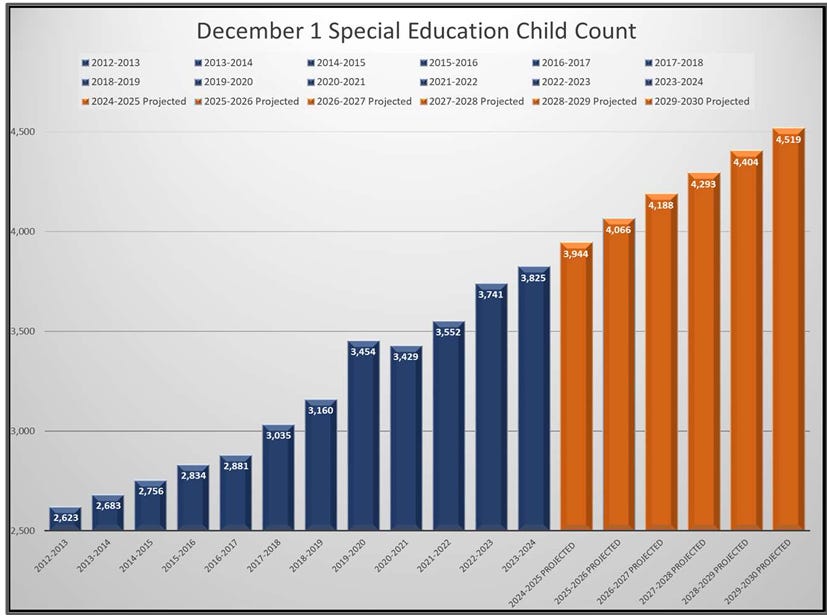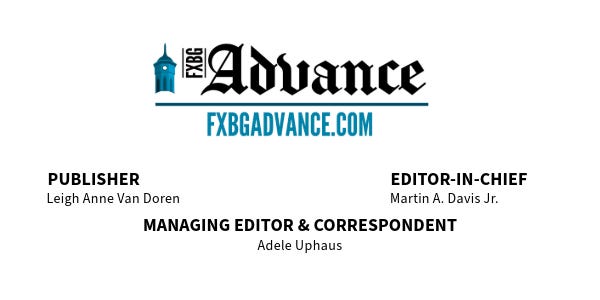More Staff Needed to Support Special Education Students in Spotsylvania
Division staff presented needs to the School Board at Monday's pre-budget work session.
By Adele Uphaus
MANAGING EDITOR AND CORRESPONDENT
Email Adele

Spotsylvania County Public Schools is struggling to support enrolled students with special education needs—a population that is projected to grow by the equivalent of an entire elementary school in four years.
The situation is especially challenging for “low incidence” students, or those who spend more than 50% of their day in a separate special education classroom.
“We were barely making it at the beginning of this year,” Allison Langridge, executive director of student support services, told School Board members at a budget work session on Monday. “All [low incidence] classrooms are exceeding [Virginia Standards of Quality] requirements [for teacher-student ratios]. Our public separate programs [Gateway and Courthouse academies at the John J. Wright Center] are currently full, which means we are sending students out to private day schools.”
The department needs 15 new teachers for low incidence programs, and plans to request funding for these positions in the budget for fiscal year 2026, which begins July 1, Langridge said.
The division began this school year with 11 fewer low incidence teachers than it needed, due to those 11 positions not being funded by the county Board of Supervisors, according to information provided to the Advance by division staff.
The School Board also requested funding for 26 paraprofessionals to support low incidence classrooms as part of the budget for the current fiscal year, but these positions were also not funded.
As a result, Langridge said Monday, the division had to reallocate five teachers and 22 paraprofessionals from high incidence programs—which support students who can spend the majority of their day in general education classrooms—in order to open the needed low incidence classrooms.
Recruitment and retention of low incidence special education teachers is an acute challenge, Langridge said Monday.
Nineteen out of 155 funded low incidence teacher positions were vacant as of early this month, and another 18 of those positions are filled by interim, non-licensed teachers.
By contrast, just five of the 152 high incidence, or “resource,” teacher positions are vacant and just seven are filled with interim teachers.
Differential pay could help recruit and retain low incidence special education teacher positions, Langridge said.
Another challenge is that interim teachers cannot manage Individual Education Plans, which all students receiving special education services have—meaning that licensed special education teachers are taking on extra work and have caseloads that are above state regulations.
“We currently have 31 special education teachers (9 early childhood & 22 elementary level) with a caseload that is above the state regulation,” staff wrote in response to questions asked by the Advance earlier this fall.
The number of students receiving special education services in Spotsylvania schools has increased each year since 2012, except for a slight dip during the 2020-21 pandemic school year. There were 2,623 enrolled special education students in 2012, according to the state-mandated December 1 count, and 3,825 as of 2023-24—and there are projected to be 4,519 by 2029-30, according to information provided at Monday’s meeting.
Langridge said there is also a need in next year’s budget for more administrative support for special education, and for a total of 43 new paraprofessional positions to support low incidence and elementary autism classrooms.
The population of English language learners has been growing along with the special education population, according to Monday’s presentation. There were just over 1,000 English language learners in 2012 and there are now 3,500 and projected to be 5,600 by 2030.
This year, the VDOE implemented new requirements for staffing at graduated levels based on where English learners are on the path to proficiency. Students at level one require a staff-to-student ratio of 1:20; those at level two 1:30; those at level three 1:40, those at level four 1:50; and those considered “reaching proficiency” 1:100.
Previously, the required staffing ratio was one teacher to 50 students no matter the proficiency level.
“Increase in ELL students and changes in Standards of Quality requirements will require additional ELL Teachers to meet the Standards of Quality,” staff noted in Monday’s presentation. “This funding does require local match based on the composite index of local ability to pay.”
The full presentation from Monday’s budget work session is available here.
Local Obituaries
To view local obituaries or to send a note to family and loved ones, please visit the link that follows.
Support Award-winning, Locally Focused Journalism
The FXBG Advance cuts through the talking points to deliver both incisive and informative news about the issues, people, and organizations that daily affect your life. And we do it in a multi-partisan format that has no equal in this region. Over the past year, our reporting was:
First to report on a Spotsylvania School teacher arrested for bringing drugs onto campus.
First to report on new facility fees leveled by MWHC on patient bills.
First to detail controversial traffic numbers submitted by Stafford staff on the Buc-ee’s project
Provided extensive coverage of the cellphone bans that are sweeping local school districts.
And so much more, like Clay Jones, Drew Gallagher, Hank Silverberg, and more.
For just $8 a month, you can help support top-flight journalism that puts people over policies.
Your contributions 100% support our journalists.
Help us as we continue to grow!















It seems to me that an extremely pro-development BOS should understand that more development brings more people, including children, to our county. They should also accept the fact that increasing numbers of children entering our school system need a sufficient number of qualified teachers. They should therefore be ready to balance those needs with a corresponding budget. We the public need to realize that we all pay a price for development and that price is often either a tax increase or a school system that can’t keep up with growth. Cost-benefit comparison.